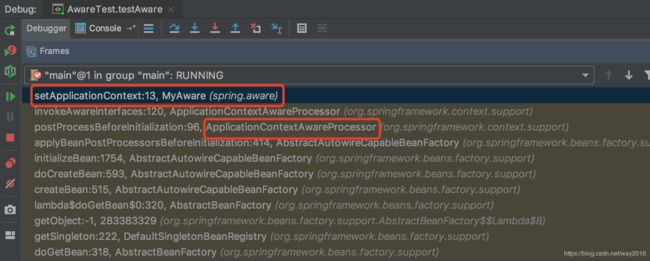spring bean初始化扩展之Aware源码解析
Spring bean初始化扩展之Aware源码解析
- 认识Aware接口
- 举例BeanFactoryAware
- spring调用Aware的setXxx进行回调通知
- 示例代码
- 工程结构
- MyAware
- AwareConfig
- AwareTest
- 运行结果
- 方法调用栈分析
认识Aware接口
package org.springframework.beans.factory;
/**
* A marker superinterface indicating that a bean is eligible to be notified by the
* Spring container of a particular framework object through a callback-style method.
* The actual method signature is determined by individual subinterfaces but should
* typically consist of just one void-returning method that accepts a single argument.
*
* Note that merely implementing {@link Aware} provides no default functionality.
* Rather, processing must be done explicitly, for example in a
* {@link org.springframework.beans.factory.config.BeanPostProcessor}.
* Refer to {@link org.springframework.context.support.ApplicationContextAwareProcessor}
* for an example of processing specific {@code *Aware} interface callbacks.
*
* @author Chris Beams
* @author Juergen Hoeller
* @since 3.1
*/
public interface Aware {
}
可以看到Aware是一个空接口,没有任何方法,它类似于java.io.Serializable接口,作用是标识某一类接口。Aware是Spring容器中非常重要的一个接口。有很多接口继承了Aware接口,如BeanFactoryAware。而实现了这些接口的bean将会被Spring容器回调通知(即调用接口中得set方法)。一般继承Aware接口的接口,会定义相应setXxx接口方法,如BeanFactoryAware定义了setBeanFactory方法,spring容器会在初始化bean时,会调用bean实现的Aware接口的setXxx方法,这个调用过程在上一篇博客有介绍。
举例BeanFactoryAware
package org.springframework.beans.factory;
import org.springframework.beans.BeansException;
/**
* Interface to be implemented by beans that wish to be aware of their
* owning {@link BeanFactory}.
*
* For example, beans can look up collaborating beans via the factory
* (Dependency Lookup). Note that most beans will choose to receive references
* to collaborating beans via corresponding bean properties or constructor
* arguments (Dependency Injection).
*
*
For a list of all bean lifecycle methods, see the
* {@link BeanFactory BeanFactory javadocs}.
*
* @author Rod Johnson
* @author Chris Beams
* @since 11.03.2003
* @see BeanNameAware
* @see BeanClassLoaderAware
* @see InitializingBean
* @see org.springframework.context.ApplicationContextAware
*/
public interface BeanFactoryAware extends Aware {
/**
* Callback that supplies the owning factory to a bean instance.
* Invoked after the population of normal bean properties
* but before an initialization callback such as
* {@link InitializingBean#afterPropertiesSet()} or a custom init-method.
* @param beanFactory owning BeanFactory (never {@code null}).
* The bean can immediately call methods on the factory.
* @throws BeansException in case of initialization errors
* @see BeanInitializationException
*/
void setBeanFactory(BeanFactory beanFactory) throws BeansException;
}
spring调用Aware的setXxx进行回调通知
AbstractAutowireCapableBeanFactory中初始化bean的源码
protected Object initializeBean(final String beanName, final Object bean, @Nullable RootBeanDefinition mbd) {
if (System.getSecurityManager() != null) {
AccessController.doPrivileged((PrivilegedAction<Object>) () -> {
invokeAwareMethods(beanName, bean);
return null;
}, getAccessControlContext());
}
else {
//调用调用此方法进行部分Aware接口的回调
invokeAwareMethods(beanName, bean);
}
Object wrappedBean = bean;
if (mbd == null || !mbd.isSynthetic()) {
//调用后置处理器的前置方法
wrappedBean = applyBeanPostProcessorsBeforeInitialization(wrappedBean, beanName);
}
try {
//调用初始化方法
invokeInitMethods(beanName, wrappedBean, mbd);
}
catch (Throwable ex) {
throw new BeanCreationException(
(mbd != null ? mbd.getResourceDescription() : null),
beanName, "Invocation of init method failed", ex);
}
if (mbd == null || !mbd.isSynthetic()) {
//调用后置处理器的后置方法
wrappedBean = applyBeanPostProcessorsAfterInitialization(wrappedBean, beanName);
}
return wrappedBean;
}
可以看到是初始化bean的几个步骤里面,在第一步进行了激活Aware接口的方法,invokeAwareMethods,其实现如下:
private void invokeAwareMethods(final String beanName, final Object bean) {
//这里主要处理 BeanNameAware BeanClassLoaderAware BeanFactoryAware这三个接口,可以看到主要是调用bean实现的Aware中的setXxx方法
if (bean instanceof Aware) {
if (bean instanceof BeanNameAware) {
((BeanNameAware) bean).setBeanName(beanName);
}
if (bean instanceof BeanClassLoaderAware) {
ClassLoader bcl = getBeanClassLoader();
if (bcl != null) {
((BeanClassLoaderAware) bean).setBeanClassLoader(bcl);
}
}
if (bean instanceof BeanFactoryAware) {
((BeanFactoryAware) bean).setBeanFactory(AbstractAutowireCapableBeanFactory.this);
}
}
}
可以看到这里主要处理了BeanNameAware BeanClassLoaderAware BeanFactoryAware这三个接口,通过调用setXxx方法,将属性设置给bean。
示例代码
工程结构
这里用ApplicationContextAware作为示例代码的接口。以下是工程结构

MyAware
package spring.aware;
import org.springframework.beans.BeansException;
import org.springframework.context.ApplicationContext;
import org.springframework.context.ApplicationContextAware;
public class MyAware implements ApplicationContextAware {
private ApplicationContext myapplicationContext;
@Override
public void setApplicationContext(ApplicationContext applicationContext) throws BeansException {
myapplicationContext = applicationContext;
System.out.println("spring容器已调用setApplicationContext进行回调通知,myapplicationContext=" + myapplicationContext);
}
public ApplicationContext getMyapplicationContext() {
return myapplicationContext;
}
}
AwareConfig
package spring.aware;
import org.springframework.context.annotation.*;
@Configuration
public class AwareConfig {
@Bean(value = "myAware")
public MyAware myAware() {
return new MyAware();
}
}
AwareTest
package spring.aware.test;
import org.junit.Test;
import org.springframework.context.ApplicationContext;
import org.springframework.context.annotation.AnnotationConfigApplicationContext;
import spring.aware.AwareConfig;
import spring.aware.MyAware;
public class AwareTest {
@Test
public void testAware() {
ApplicationContext applicationContext = new AnnotationConfigApplicationContext(AwareConfig.class);
MyAware myAware = (MyAware) applicationContext.getBean("myAware");
System.out.println("从容器中获取的myAware="+myAware + ",其applicationContext属性=" + myAware.getMyapplicationContext());
}
}
运行结果
方法调用栈分析

前面我们分析了BeanNameAware BeanClassLoaderAware BeanFactoryAware这三个接口是在初始化bean的第一步就做了处理。通过上图这个调用栈可以看到,其它实现的Aware的接口,则通过相应的后置处理器(如这里的ApplicationContextAwareProcessor)进行间接处理,最终调用了相应的setXxx方法。
ApplicationContextAwareProcessor
@Override
@Nullable
public Object postProcessBeforeInitialization(final Object bean, String beanName) throws BeansException {
AccessControlContext acc = null;
if (System.getSecurityManager() != null &&
(bean instanceof EnvironmentAware || bean instanceof EmbeddedValueResolverAware ||
bean instanceof ResourceLoaderAware || bean instanceof ApplicationEventPublisherAware ||
bean instanceof MessageSourceAware || bean instanceof ApplicationContextAware)) {
acc = this.applicationContext.getBeanFactory().getAccessControlContext();
}
if (acc != null) {
AccessController.doPrivileged((PrivilegedAction<Object>) () -> {
invokeAwareInterfaces(bean);
return null;
}, acc);
}
else {
//调用激活Aware接口
invokeAwareInterfaces(bean);
}
return bean;
}
private void invokeAwareInterfaces(Object bean) {
//根据不同接口调用相应的setXxx方法
if (bean instanceof Aware) {
if (bean instanceof EnvironmentAware) {
((EnvironmentAware) bean).setEnvironment(this.applicationContext.getEnvironment());
}
if (bean instanceof EmbeddedValueResolverAware) {
((EmbeddedValueResolverAware) bean).setEmbeddedValueResolver(this.embeddedValueResolver);
}
if (bean instanceof ResourceLoaderAware) {
((ResourceLoaderAware) bean).setResourceLoader(this.applicationContext);
}
if (bean instanceof ApplicationEventPublisherAware) {
((ApplicationEventPublisherAware) bean).setApplicationEventPublisher(this.applicationContext);
}
if (bean instanceof MessageSourceAware) {
((MessageSourceAware) bean).setMessageSource(this.applicationContext);
}
if (bean instanceof ApplicationContextAware) {
((ApplicationContextAware) bean).setApplicationContext(this.applicationContext);
}
}
}
可以猜想,其他Aware的调用时机,也应该是通过相应的后置处理器进行处理,间接调用相应的setXxx方法。
